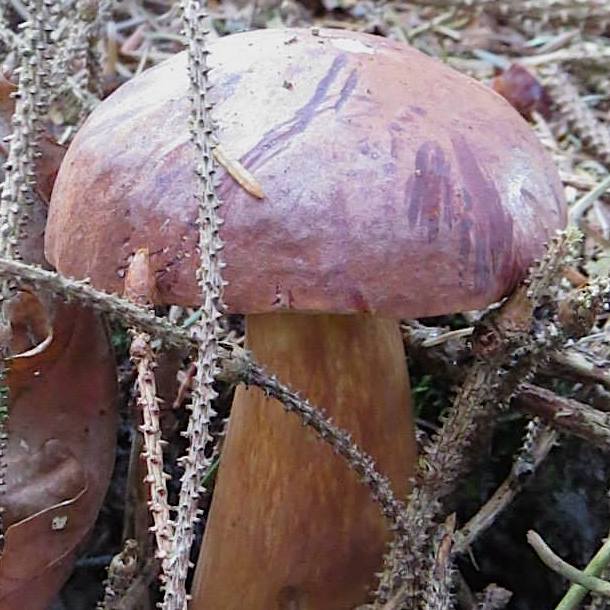
Penny Bun mushrooms are not often found on The Lizard; these were spotted in a spruce plantation.
Photo: Steve Townsend
Scientific name: Boletus edulis
Other common names: Cep, Porcino. The Swiss name translates as Squirrel’s Bread.
What to look for:
- Appearance: Reddish to yellow-brown large cap with pale edge, slightly greasy to the touch, convex and flattening with age, up to 35 cm diameter. Underneath it is white changing to green-yellow with maturity; it has pores rather than gills (in common with other Boletus genus fungi). Cream to yellow barrel- or club-shaped stem, showing reticulation (a raised pattern).
- Spores: Olive-brown spore print.
- Where: Global distribution is Europe, Asia and North America. Look for it in forests and plantations, growing on soils below trees; prefers drier locations.
- When: The fruiting bodies are produced in summer and autumn.
- Similar species: Some other mushrooms in the same family. Tylopilus felleus (Bitter Bolete) looks similar but has the taste its common name suggests, making it inedible.
Penny Bun, also known as Cep, is a much sought after mushroom. Prized in cuisine, especially in Italy where it is known as porcino (meaning porcine, or pig-like), it is however very hard to cultivate. It is therefore often foraged and collected for onward sale, often in dried and packaged form. It would be hard to beat a freshly collected specimen however, with its nutty flavour and firm texture.
The life-story of a Penny Bun is as fascinating as its flavour is tasty. Like all the common Boletus fungi found in the UK, it is ectomycorrhizal, i.e. it forms a mutually beneficial relationship with the roots of trees. This is why you will only ever find Penny Buns in association with a tree (though they may be located a few metres away from a host tree that has a broad root system). The fruiting body that appears in the summer and autumn in order to spread spores and reproduce is only the generally visible part of the fungus. Below the ground it forms tissue round and penetrates the tree root tips. This does no harm to the tree: in return for helping provide the tree with essential soil minerals, the tree passes nutrients to the fungus.

Boletus species do not have gills. Look at the underside of the cap (see photo above) and you will notice it is made up instead of pores. These are the ends of tubes that extend from the cap; the spores are released from these tubes through the pores on reaching maturity.
Did you know…?
…The genus name Boletus means lump of clay, while the species name edulis means edible. Penny Bun is doubtless much tastier than a lump of clay, though!
…Folklore tells us that the full moon is the best time to hunt for Penny Buns; conversely, in Italy the mushrooms are said to develop at the new moon. A more useful tip is to hunt in woodland edges a few days after rainfall.
More information and references:
Buczacki, S., Shields, C., Ovenden, D., 2012. Collins Fungi Guide. Collins, London.
Published: December 2014
Author: Amanda Scott
Photos: Steve Townsend
